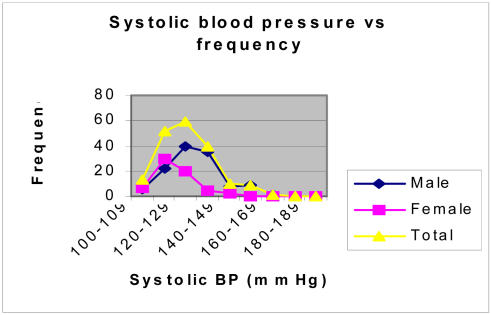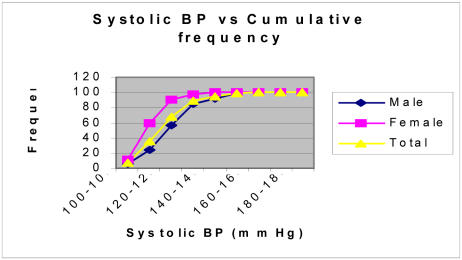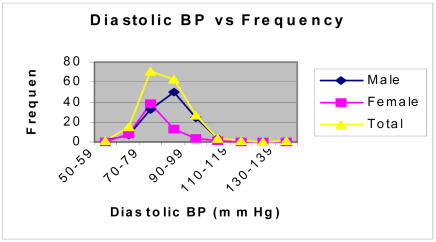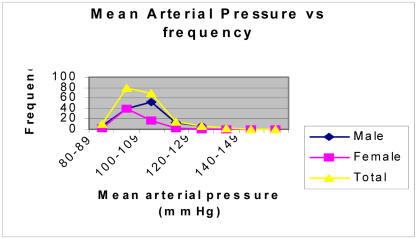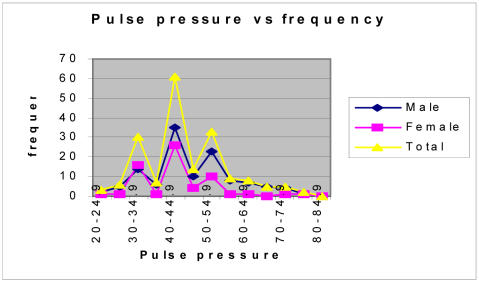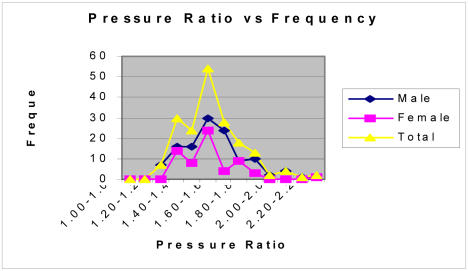Abstract
The purpose of this study was to set reference values for spot blood pressure and its derivatives among Makerere university undergraduate students.
Study Design
This was a cross- sectional study.
Materials and methods
A total of 183 undergraduates including 63 females and 120 males participated in the study. Blood pressure was measured, with the respondent seated, using a sphygmomanometer. Mean arterial pressure was determined as the average of the systolic and diastolic values. Pulse pressure was the difference between systolic and diastolic values. Dividing systolic by diastolic values gave the required ratio. Histograms and cumulative percentages of these results were plotted and used to set the central 95th percentile range as the reference values.
Results
Empirical ranges were: systolic BP 100–179 mmHg; diastolic BP 60–139 mmHg; systolic: diastolic pressure ratio 1.20–2.30 mmHg, mean arterial pressure 80–159 mmHg and pulse pressure 20–85 mmHg. The reference ranges covering the central 95 percentile were: systolic BP 100–150 mmHg, diastolic BP 64–100, systolic: diastolic BP ratio 1.29–2.03, the mean arterial pressure 85–121 mmHg, and pulse pressure 25–70 mmHg. According to the systolic pressure, 35% were normal, 54% pre-hypertensive and 11% hypertensive. According to diastolic values, 48% were normotensive, 43% pre-hypertensive and 18% hypertensive. The mean arterial pressure was distributed like the parent pressures. The pulse pressure and the systolic:diastolic ratio were trimodally distributed with the three peaks corresponding to normotension, pre-hypertension and hypertension.
Conclusion and recommendation
Reference values for the university student population have been derived and they are recommended for application in clinical evaluation.
Introduction
Blood pressure is the pressure of blood against the walls of the arteries. Blood pressure results from two forces: one is created by the heart as it pumps blood into the arteries through the circulatory system and the other is the force exerted by the arteries as they resist the blood flow1. Each time the blood pressure is checked, two figures are recorded: the upper, or systolic pressure, and the lower, or diastolic pressure. The normal range varies with age, but a young adult would be expected to have a systolic pressure of around 120 mmHg and a diastolic pressure of around 80 mm of mercury.2, 3.
There are several reasons for studying the casual blood pressure in any community: a) it has the most ready application to clinical medicine as it is used by all doctors all the time; b) it is the pressure which people live with most of their wake lives; c) the data obtained may be generally comparable with those found in other casual blood pressure surveys; d) and the demands on the population are not arduous, an important fact for epidemiological work4, 5
High blood pressure (hypertension) is considered when a blood pressure of 140/90 or higher is recorded three or more consecutive times. With high blood pressure, the heart works harder, the arteries take a beating, and the chances of stroke, heart attack, and kidney problems are greater 6.
High blood pressure is a silent danger because there are no typical symptoms sending out early warning signals. On the contrary, many people feel well and energetic despite their high blood pressure. There is only one-way of finding out whether or not one's pressure is normal and that is to have it checked. Blood pressure measurements must be repeated at least once every year. If an elevated pressure is detected early, prompt treatment can help prevent the possible fatal consequences7.
There has been much debate on the relative importance of systolic and diastolic hypertension in epidemiological studies. Both systolic and diastolic blood pressures are important risk factors for cardiovascular disease6. There is evidence to suggest that certain derivatives of systolic and diastolic measurements may be the most important risk indicators in some patient categories8.
Derivatives of systolic and diastolic blood pressure
The most commonly used derivatives of systolic and diastolic pressure include the mean arterial pressure, the pulse pressure and the systole/diastole pressure ratio.
The Mean Arterial Pressure
The mean arterial pressure (MAP) is the perfusion pressure experienced by end organs such as the kidney, the liver and bones. This pressure converts pulsatile systolic and diastolic pressure into a continuous pressure that determines the average rate of blood flow from the left ventricle to the right atrium9. To determine MAP with accuracy, analogue electric circuitry or digital techniques that are either invasive, or expensive and sometimes both, are needed10. In field practice, MAP is taken as the average arterial blood pressure, obtained by taking the average of systolic and diastolic pressure.
The pulse pressure
The difference between the systolic and diastolic pressure is called the pulse pressure. It is an important predictor of cardiovascular events and predicts the risk of congestive heart failure in the elderly8. It is associated with ventricular hypertrophy and increases with age as the aortic compliance decreases10. Measurement of pulse pressure continues to gain support as a potential and clinically useful predictor of cardiovascular disease risk and all-cause of mortality in a variety of populations11. It is the most important component of pressure associated with severe coronary heart disease6.
Systolic: Diastolic ratio
The systolic / diastolic ratio is the systolic pressure divided by the diastolic pressure.
This ratio with its variants is useful in obstetrics 12, 13 and in cases of acute myocardial infarction14.
Worldwide population differences do exist as the findings in the Kikuyu and Samburu showed that indigenous neighbouring communities in Africa may differ from one another, in blood pressure levels just as they may from Europeans5.
As the number of fatalities from cardiovascular disease declines in western industrialised nations, the reverse has been observed in East Africa 15. Hypertensive heart disease was, as far back as 1969, reported as a major cardiovascular problem in the African population attending Mulago Hospital, Kampala16. To date, uncontrolled systemic hypertension is the most important risk factor for cardiac disease and heart failure at Mulago Hospital17.
Therefore the aim of this work was to establish reference values of systolic and diastolic pressure and their derivatives among Makerere University undergraduate students.
Materials and Methods
Study site
Casual blood pressure measurements were carried out in the nine halls of residence at the main campus of Makerere University in Kampala, Uganda.
Study population
The study involved healthy male and female consenting undergraduate students, aged between 20 and 26 years. Pregnant students were excluded.
Procedures
Questionnaire
The participants were given self-administered questionnaires to provide information on demographic, lifestyle and health characteristics.
Blood Pressure Measurements
Systolic blood pressure (SBP) and diastolic blood pressure (DBP) were measured to the nearest one-millimeter of mercury while the participant was seated using a sphygmomanometer and stethoscope.
Data analysis
The systolic and diastolic blood pressure values were used to derive the mean arterial pressure, pulse pressure and systolic: diastolic ratios, which were then plotted in histograms to establish the pattern of distribution. The central 95 percentile read off cumulative percent curves gave the reference values.
Results
One hundred and eighty three students, 120 males and 63 females participated in the study. The age ranged from 20 to 26 years.
Systolic blood pressure
The systolic blood pressure ranged from 100 to179 mmHg. As shown in Figure 1 the distribution is positively skewed.
Figure 1a.
Distribution of systolic pressure among undergraduate students.
The central 95th percentile reference range is 100 to 150 mmHg as read off the cumulative curve shown in figure 1b.
Figure 1b.
Cumulative percentages of systolic blood pressure among under graduate students.
Diastolic pressure
The diastolic blood pressure ranged from 60 to 139 mmHg. As shown in figure 2, the distribution is positively skewed.
Figure 2.
Distribution of diastolic blood pressure among under graduate students
The central 95th percentile range is from 64 to 100 mmHg as read off a cumulative percentage curve (not shown).
Mean arterial pressure
The mean arterial pressure ranges from 80 to 159 mmHg. As shown in Figure 3, the distribution is positively skewed.
Figure 3.
The mean arterial pressure distribution among under graduate students
The central 95th percentile ranges from 85 to 121 mmHg as read off from a cumulative percentage curve.
Pulse pressure
The pulse pressure ranged from 20 to 85 mmHg (Figure 4). The distribution is tri-modal and positively skewed.
Figure 4.
The pulse pressure distribution among under graduate students
The central 95th percentile ranges from 25 to 70 mmHg as read off from a cumulative percentage curve.
Systolic: diastolic ratio
The systolic: diastolic pressure ratio ranged from 1.20 to 2.30 mmHg (Figure 5). The distribution is tri-modal and positively skewed.
Figure 5.
Systolic: diastolic ratio distribution among under graduate student
The central 95th percentile ranges from 1.29 to 2.03 mmHg as read off a cumulative percentage curve.
Blood pressure categorisation of Makerere University undergraduate students based on international standards10
a) Systolic blood pressure
Table 1 gives the detailed classification according to sex.
Table 1.
Systolic blood pressure classification of Makerere University undergraduate students
| Category | Systolic range: (mmHg) | Percentage of | ||
| Males (n=120) |
Females (n=63) |
|||
| Normal | Less than 120 | 23 | 59 | |
| Pre-hypertensive | 120–139 | 62 | 38 | |
| Hypertensive | ||||
| Stage 1 | 140–159 | 14 | 3 | |
| Stage 2 | 160 or more | 1 | 0 | |
Using the systolic blood pressure, 36% of the sample population is normotensive while 53% are pre-hypertensive and 11% are hypertensive.
b) Diastolic blood pressure
Table 2 gives the detailed classification according to sex
Table 2.
Diastolic blood pressure classification using international standards among Makerere University undergraduate students
| Diastolic range: (mmHg) | Percentage of | |||
| Males (n=120) |
Females (n=63) |
|||
| Normal | Less than 80 | 34 | 73 | |
| Pre-hypertensive | 80–89 | 42 | 20 | |
| Hypertensive | ||||
| Stage 1 | 90–99 | 20 | 5 | |
| Stage 2 | 100 or more | 4 | 2 | |
Using the diastolic pressure, 48% of the sample population is normotensive while 34% is pre-hypertensive and 18% is hypertensive.
c) Mean arterial pressure
MAP is not routinely used in patient investigation and so far has no international reference values. Our results, however, show the same distribution pattern as those of diastolic and systolic pressure.
d) Pulse pressure
There are so far no published internationally standardized values for pulse pressure to which these results could be compared. Our results, however, are categorised into three clusters with peaks at 35, 45, and 55 mmHg.
e) Systolic: diastolic ratio
This ratio is not routinely used in patient management, so there are no values to refer to. None the less, our results are categorized into three groups of peaks at 1.4, 1.6 and 1.8. These correspond to the three peaks of the pulse pressure.
Summary of reference ranges
Table 3 gives a summary of the reference ranges within the central 95 percentile of each statistic among the university undergraduate students.
Table 3.
Established reference ranges among undergraduate students
| Statistic | unit | Range |
| Systolic BP | mmHg | 100 – 150 |
| Diastolic BP | mmHg | 64 – 100 |
| Mean arterial BP | mmHg | 85 – 121 |
| Pulse pressure | mmHg | 25 – 70 |
| Systolic/diastolic BP | ratio | 1.29 – 2.03 |
Discussion
The distribution of systolic and diastolic pressure obtained in this work is in agreement with many epidemiological studies, which show that blood pressure in the population has a distribution curve that is slightly skewed to the right18. The mean arterial pressure is distributed like the “parent” pressures of systole and diastole. This is the first time these patterns are reported among Ugandans.
The trimodal distribution of pulse pressure and systolic:diastolic ratio is being reported for the first time to the best of our knowledge and is apparently not used conventionally in patient management. The three peaks correspond respectively to normotension, prehypertension and hypertension.
According to the international reference values given above, it has been shown in this work that some of the university student population have systolic and diastolic pressure values of clinical pre-hypertension and hypertension. Although it is commonly believed that essential hypertension usually begins between 35 and 45 years18and worsens with age, our findings show imminent danger of hypertension in a young population of 20–26 years. The risk group needs to be put under medical surveillance to confirm the hypertension and to study predisposing factors.
Although mean arterial pressure (MAP) is not routinely considered by clinicians in patient management it is important because it is the pressure experienced by the end organs which, on average, demand a minimum of 60 mm Hg19. The student sample has MAP range of 85–121 mmHg, which is well above the essential minimum that negates systemic ischaemia.
The pulse pressure is an indicator of stiffness and inflammation in the vessel walls; the higher the value, the greater the risk of cardiovascular disease11. Although not yet used by clinicians to determine the treatment, evidence suggests that it may prove a strong indicator of heart problems20, 21. For example, recent studies have indicated that a 10 mm Hg wider pulse pressure increased the risk of major cardiovascular complications22. The tri-modal profile obtained in this work outlines normotension, pre-hypertension, and hypertension of both systolic and diastolic origin. This is the first time these derivatives are reported among Ugandans. The pulse pressure and the systolic:diastolic pressure ratio may turn out to be diagnostic statistics to identify risky groups which require medical surveillance.
Conclusions and Recommendations
Systolic, diastolic and mean arterial pressures are each distributed normally with a slight positive skew.
Pulse pressure and systolic:diastolic pressure ratio are trimodally distributed and should be considered in clinical situations.
Population reference values for university students have been derived.
Further studies are needed to evaluate the clinical significance of mean arterial pressure, pulse pressure and systolic:diastolic pressure ratio.
Acknowledgments
We acknowledge SIDA/SAREC Uganda for funding the study.
References
- 1.Kannel W B, Castelli W P, McNamara P M, Mckee P A, Feinleib M. Role of blood pressure in the development of congestive heart failure: The Framingham Study. N Engl J Med. 1972;287:781–787. doi: 10.1056/NEJM197210192871601. [DOI] [PubMed] [Google Scholar]
- 2.Simon Harvey. Editor-in-Chief, Well-Connected reports. Harvard Medical School, Massachusetts General Hospital; High Blood Pressure. [Google Scholar]
- 3.Nichols W W, O Rourke M F. McDonald's blood flow in arteries. 3rd Edition. Philadelphia Lea & Febiger; 1990. pp. 216–250. [Google Scholar]
- 4.Parry E H O. Ethiopian cardiovascular studies III: The casual blood pressure in Ethiopian highlanders in Addis Ababa. East Afr Med J. 1969;46(5):246–256. [PubMed] [Google Scholar]
- 5.Williams AW. Blood pressure differences in Kikuyu and Samburu Communities in Kenya. East Afr Med J. 1969;46(5):262–272. [PubMed] [Google Scholar]
- 6.Scottish Intercollegiate Guidelines Network, 9 Queen Street, Edinburgh EH2 IJQ, Sign 2001.
- 7.Wolff H P. Speaking of High Blood Pressure. Sterling Publishers Pvt Ltd; 1996. pp. 33–65. [Google Scholar]
- 8.Haider A W, Larson M G, Franklin S S, Levy D. Systolic blood pressure, Diastolic blood pressure and Pulse pressure as predictors of risk for congestive heart failure in the Framingham Heart Study. Ann Intern Med. doi: 10.7326/0003-4819-138-1-200301070-00006. http://www.annals.org/cgi/content/full/138/1/10. [DOI] [PubMed] [Google Scholar]
- 9.Pflanzer R. Exercise Physiology: Automatic non invasive blood pressure. Biopac Systems. 2002 [Google Scholar]
- 10.Klabunde R E. Cardiovascular Physiology Concepts Revised 2004. http://ww.oucom.ohiou.edu/CV Physiology/BP003.htm.
- 11.Bruce J. Pulse pressure builds steam as mortality predictor - brief article - statistical data included. Family Practice News. 2000:1–3. [Google Scholar]
- 12.Nakayi Y, Mine M, Nishio J, Maeda T, Imancka M, Ogita S. Effects of maternal prone position on the umbilical arterial flow. Acta Obst et Gyneco Scand. 1998;77(10):967. [PubMed] [Google Scholar]
- 13.Park Y W, Cho J S, Kumi H S, Kim J S, Song C H. The clinical implications of early diastolic notch in third trimester Doppler waveform analysis of the uterine artery. Journal of Ultrasound Medicine. 1996;15(1):47–51. [PubMed] [Google Scholar]
- 14.Importance of Systolic and Diastolic function after AMI. www.medscape.com/viewarticle/448540-34k.
- 15.Mbaya V B. Hypertension in East Africans and Others of African Descent: A Review. East Afr Med J. 1998;75(5):300–303. [PubMed] [Google Scholar]
- 16.Sharper A G, Saxton G A. Blood pressure and body build in a rural community in Uganda. East Afr Med J. 1969;46(5):228–245. [PubMed] [Google Scholar]
- 17.Achadu C A. The Pattern of cardiac disease and aetiology of cardiac failure among patients attending Mulago Cardiac Clinic and Medical Wards. Kampala, Uganda: Makerere University; 2000. M. Med Dissertation. [Google Scholar]
- 18.Lindop GBN. Hypertension Chapter 12.5 in Oxford Text book of Pathology. In: McGee JOD, et al., editors. Pathology Systems. 2a. Oxford University Press; 1992. pp. 833–841. [Google Scholar]
- 19.Mean Arterial Pressure: Wikipedia, the free encyclopedia. hhhttp://en.wikipedia.org/wiki/mean_arterial_pressure.
- 20.Benetos A, Safar M R, Ruduichi A, Simulyan H, Richard J L, Ducimetieere P, et al. Pulse Pressure as a predictor of long term cardiovascular mortality in a French male population. Ann Epidemiol. 1997;9(30):1410–1415. doi: 10.1161/01.hyp.30.6.1410. [DOI] [PubMed] [Google Scholar]
- 21.De Sousa A, Marconi J, Joao L, Hermann V, Joao B, et al. Evaluation of systolic, diastolic and pulse pressure as risk factors for severe coronary arteriosclerotic disease in women with unstable angina non-ST-elevation acute myocardial infarction. Arq Bras Cardiol. 2004;82(5):1–14. doi: 10.1590/s0066-782x2004000500005. [DOI] [PubMed] [Google Scholar]
- 22.Mercola J. Pulse pressure good predictor of heart disease. Total Health Program. http://www.mercola.com/2000/sep/24/pulse_pressure.htm.



